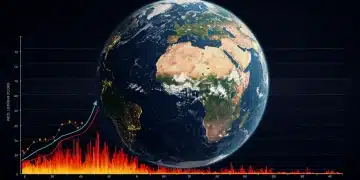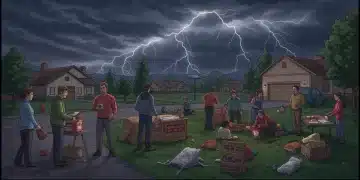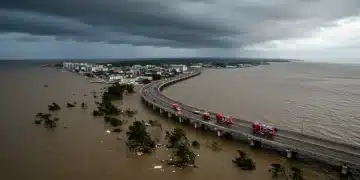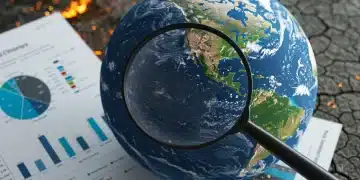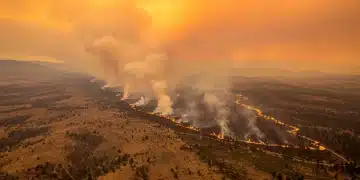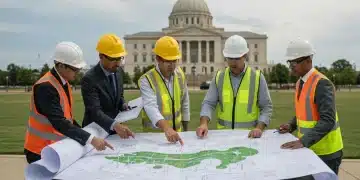Extreme Weather Events U.S. Up 15% Last Decade
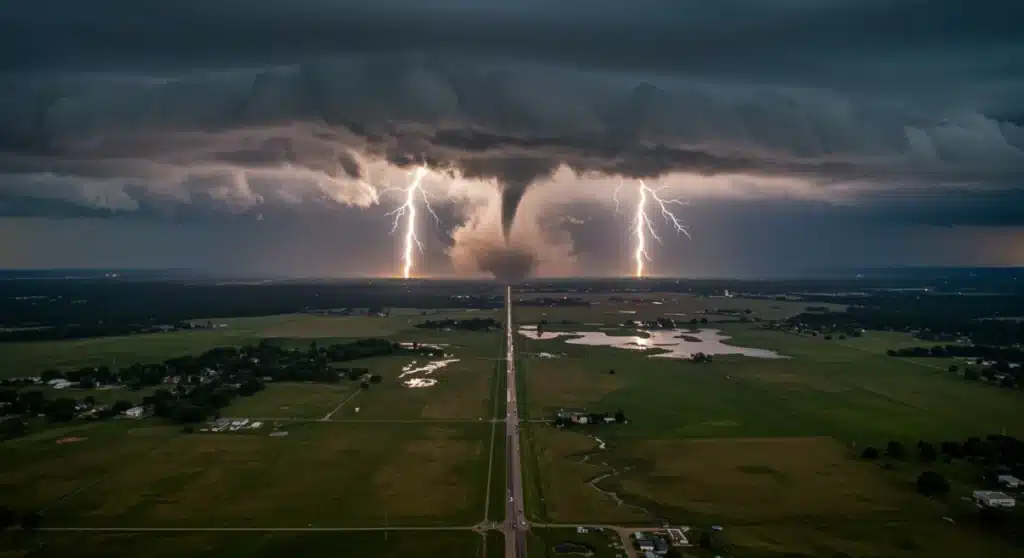
New data confirms a 15% increase in extreme weather events across the U.S. over the last decade, signaling escalating climate change impacts on communities and national infrastructure.
Understanding the 15% Increase in Extreme Weather Events in the U.S. Over the Last Decade (INSIDER KNOWLEDGE) reveals a stark and urgent reality for communities nationwide. Recent analyses highlight a significant uptick in the frequency and intensity of these destructive events, prompting critical questions about preparedness, mitigation, and the underlying drivers of this alarming trend.
The Alarming Rise in Extreme Weather Incidents
The United States has experienced a quantifiable and concerning surge in extreme weather events over the past ten years. This isn’t merely anecdotal; scientific data, compiled by agencies like the National Oceanic and Atmospheric Administration (NOAA), indicates a clear 15% increase in both the number and severity of these incidents. This includes everything from devastating hurricanes and prolonged heatwaves to intense droughts and unprecedented winter storms.
This escalating pattern poses severe challenges to infrastructure, public safety, and economic stability. As of late 2023, the financial toll from these events has reached hundreds of billions of dollars annually, with human lives also tragically lost. The data underscores a critical need for updated strategies in disaster preparedness and climate resilience.
Defining ‘Extreme Weather’ in the Modern Era
What exactly constitutes ‘extreme weather’ in this context? It refers to weather phenomena that are unusual, severe, or unseasonable, and which have significant impacts on human life, property, or the environment. The recent increase encompasses a broad spectrum of events:
- Heatwaves: Record-breaking temperatures leading to public health crises and increased energy demand.
- Wildfires: Larger, more intense, and longer-lasting fires, particularly in the Western U.S.
- Tropical Storms & Hurricanes: More rapid intensification and slower movement, leading to greater rainfall and storm surge.
- Flooding: Both coastal and inland flooding, often exacerbated by heavy precipitation events.
- Droughts: Prolonged periods of water scarcity affecting agriculture and water resources.
Driving Factors Behind the Escalation
The consensus among climate scientists points overwhelmingly to anthropogenic climate change as the primary catalyst for the observed 15% increase in extreme weather events. The planet’s warming atmosphere holds more moisture, fueling more intense precipitation, while also contributing to prolonged dry spells and higher temperatures. This complex interplay of atmospheric changes creates a fertile ground for more frequent and severe weather anomalies.
Ocean warming also plays a crucial role, particularly in the intensification of tropical cyclones. Warmer ocean waters provide more energy for hurricanes, leading to faster intensification rates and higher wind speeds. The melting of polar ice caps and glaciers contributes to sea-level rise, making coastal areas more vulnerable to storm surges and high-tide flooding.
The Role of Atmospheric Dynamics
Changes in atmospheric circulation patterns are also contributing factors. The jet stream, a high-altitude wind current that influences weather systems, appears to be becoming wavier and slower. This can lead to weather patterns becoming ‘stuck’ for longer periods, resulting in prolonged heatwaves, droughts, or heavy rainfall events in specific regions. Such shifts in global wind patterns are directly linked to Arctic warming and its impact on temperature gradients.
Furthermore, increased levels of greenhouse gases like carbon dioxide and methane trap heat in the atmosphere, leading to a warmer global average temperature. This additional heat energy then manifests in various forms of extreme weather, creating a feedback loop where warming begets more extreme events, which in turn can accelerate warming.
Regional Impacts Across the U.S.
The impact of this 15% increase in extreme weather events is not uniformly distributed across the U.S.; different regions face distinct and escalating threats. The Western United States, for instance, grapples with persistent droughts and increasingly destructive wildfires, which have ravaged vast swaths of land and impacted air quality across the continent. States like California and Oregon have seen record-breaking fire seasons, forcing mass evacuations and causing billions in damages.
Conversely, the Gulf Coast and Southeastern states are experiencing a heightened frequency and intensity of hurricanes and tropical storms. These events bring not only powerful winds but also torrential rainfall and devastating storm surges, leading to widespread flooding and long-term recovery challenges for communities. The Northeast and Midwest are not immune, facing more frequent heavy rainfall events, often leading to flash floods and agricultural losses.

Varying Vulnerabilities and Preparedness
Each region’s unique geography, population density, and socio-economic factors contribute to varying levels of vulnerability and preparedness. Coastal communities, for example, face the dual threat of rising sea levels and intensifying storms, necessitating significant investments in resilient infrastructure. Agricultural regions, on the other hand, struggle with unpredictable rainfall patterns, impacting crop yields and food security.
- Western U.S.: Increased risk of mega-droughts, wildfires, and water scarcity.
- Southeastern U.S.: Higher frequency of severe hurricanes, coastal erosion, and inland flooding.
- Midwest: More intense rainfall events, riverine flooding, and heatwaves.
- Northeast: Extreme precipitation, coastal storms, and rising sea levels.
Economic and Social Repercussions
The escalating trend of extreme weather events carries profound economic and social repercussions for the U.S. The financial burden is immense, stemming from direct damages to property, infrastructure, and agricultural lands, as well as indirect costs such as business interruption, emergency response, and long-term recovery efforts. According to NOAA, the U.S. has sustained 376 separate weather and climate disasters since 1980 where overall damages/costs reached or exceeded $1 billion (including CPI adjustment to 2023). The total cost of these 376 events exceeds $2.660 trillion.
Beyond the monetary costs, there are significant social impacts. Displacements due to disasters can lead to housing crises, mental health challenges, and disruptions to education and healthcare services. Vulnerable populations, including low-income communities and minority groups, are often disproportionately affected, exacerbating existing inequalities and hindering their ability to recover.
Impact on Key Sectors
Various sectors are feeling the strain:
- Agriculture: Crop failures from droughts or floods, livestock losses, and increased input costs.
- Insurance: Rising premiums, difficulty in obtaining coverage in high-risk areas, and increased payouts.
- Tourism: Damage to natural attractions, disruption of travel, and reduced visitor numbers in affected regions.
- Public Health: Heat-related illnesses, spread of vector-borne diseases, and mental health issues post-disaster.
The ripple effects extend throughout the economy, influencing supply chains, labor markets, and national fiscal stability. The need for robust disaster relief and resilient economic planning has never been more critical.
Adaptation and Mitigation Strategies
In response to the 15% increase in extreme weather events, both adaptation and mitigation strategies are being developed and implemented across the U.S. Adaptation focuses on adjusting to current and future climate impacts, such as building stronger infrastructure, developing early warning systems, and implementing nature-based solutions like wetland restoration to absorb floodwaters. Many cities are now investing in green infrastructure to manage stormwater and reduce urban heat island effects.
Mitigation, on the other hand, aims to reduce the underlying causes of climate change, primarily by cutting greenhouse gas emissions. This involves transitioning to renewable energy sources, improving energy efficiency, and promoting sustainable land use practices. Federal and state governments are initiating programs to incentivize these changes, while private sector innovation also plays a key role in developing cleaner technologies.
Community-Level Resilience Efforts
At the community level, resilience building is paramount. This includes:
- Updated Building Codes: Requiring new construction to withstand stronger winds, heavier snowfalls, or earthquake activity.
- Relocation & Buyout Programs: Assisting communities in moving away from high-risk floodplains or coastal areas.
- Emergency Preparedness: Enhancing communication systems, evacuation plans, and public awareness campaigns.
These efforts require significant investment and coordinated action across all levels of government, private industry, and civil society. The goal is not just to recover from disasters but to build communities that are inherently more resistant to future extreme weather challenges.
The Path Forward: Policy and Public Awareness
Addressing the 15% increase in extreme weather events necessitates a robust and forward-thinking policy framework coupled with heightened public awareness. Policymakers are increasingly acknowledging the urgency of the situation, with discussions centering on comprehensive climate legislation that includes carbon pricing, renewable energy mandates, and increased funding for climate research and resilient infrastructure. The Biden administration, for instance, has emphasized climate action as a core priority, aiming to rejoin international climate agreements and set ambitious emissions reduction targets.
Public awareness and education are equally vital. Understanding the scientific consensus on climate change and its direct link to extreme weather can foster greater public support for policy initiatives and encourage individual and community-level actions. Educational campaigns can inform citizens about preparedness measures, energy conservation, and sustainable consumption choices, empowering them to contribute to a more resilient future.
International Cooperation and Innovation
The scale of the challenge also demands international cooperation. Climate change is a global phenomenon, and effective solutions require coordinated efforts among nations to reduce global emissions and share best practices in adaptation. Technological innovation, particularly in areas like carbon capture, advanced renewable energy, and climate modeling, will be crucial in accelerating the transition to a low-carbon economy.
The path forward is complex, requiring sustained commitment, innovative solutions, and a collective will to protect communities and ecosystems from the intensifying impacts of extreme weather. The growing body of scientific evidence and the tangible experiences of communities across the U.S. underscore the imperative for immediate and decisive action.
| Key Aspect | Brief Description |
|---|---|
| Increase Rate | Extreme weather events in the U.S. have risen by 15% in the last decade. |
| Primary Cause | Anthropogenic climate change, including global warming and altered atmospheric patterns. |
| Key Impacts | Significant economic costs, infrastructure damage, and social disruption across various U.S. regions. |
| Solutions | Adaptation strategies, mitigation efforts, policy changes, and enhanced public awareness. |
Frequently Asked Questions About Extreme Weather Events
The increase includes a rise in severe heatwaves, intense wildfires, more powerful hurricanes, heavy rainfall leading to floods, and prolonged droughts. These events vary in prevalence and intensity depending on the specific U.S. region.
Climate change, driven by greenhouse gas emissions, warms the atmosphere and oceans. This extra energy fuels more intense weather systems, alters atmospheric circulation, and increases the moisture-holding capacity of the air, all contributing to extreme events.
The Western U.S. faces severe droughts and wildfires, while the Gulf Coast and Southeast experience more intense hurricanes and coastal flooding. The Midwest and Northeast are seeing increased heavy rainfall and flash flood events.
Economic consequences include billions in property and infrastructure damage, agricultural losses, increased insurance costs, business disruptions, and significant expenses for emergency response and long-term recovery efforts across affected areas.
Mitigation involves reducing emissions through renewable energy and efficiency. Adaptation includes building resilient infrastructure, improving early warning systems, and implementing nature-based solutions. Both require policy changes and public engagement.
Looking Ahead: Preparing for a Changing Climate
The 15% increase in extreme weather events in the U.S. over the last decade is not merely a statistic; it’s a critical indicator of a rapidly changing climate with profound implications for the future. As communities continue to grapple with the immediate aftermath of these events, the focus shifts to proactive measures. Expect to see continued emphasis on federal and state funding for climate resilience projects, particularly in vulnerable coastal and wildfire-prone regions. Debates around climate policy will intensify, driven by the increasing frequency and cost of disasters. Furthermore, advancements in climate science and predictive modeling will be crucial for enhancing early warning systems and informing long-term planning. The ongoing challenge will be translating scientific understanding into actionable policies and widespread public engagement to safeguard lives and livelihoods.
